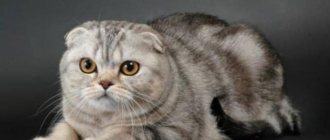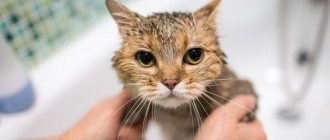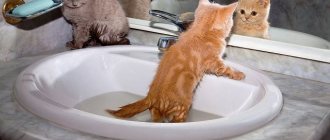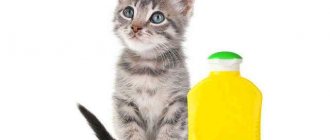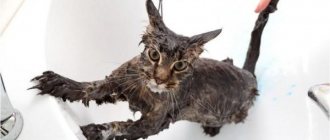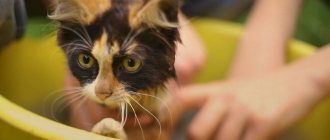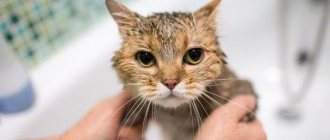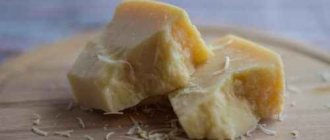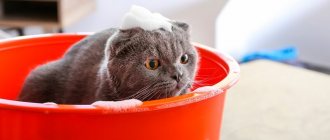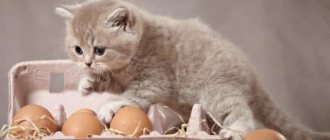Owners of cats and kittens are wondering how many times to wash their pet in a certain period of time. The owners' opinions did not agree. Some people think that it is impossible to bathe domestic cats at all, because these animals themselves love cleanliness, constantly lick their fur and do not need additional care, and they do not like water. The latter are confident in the importance of helping a pet maintain hygiene. But the truth lies in the middle.
Scottish fold sleeping place
The sleeping place should be quiet and calm so that the kitten can fully rest.
Choose a mattress no wider than 10 centimeters, not too soft. It is acceptable to use a sheep's wool ski mat or a special bed for kittens as a sleeping place. You can also buy or make your own house for a kitten. Its frame is cut out of thick cardboard, which can be wrapped with padding polyester, cotton wool or other soft material, and covered with natural fabric, for example, chintz sewing scraps. In such a house, a fold-eared cat can comfortably sleep.
Scottish Fold kittens are peaceful, curious and people-oriented creatures. With the right approach to education and care, you will get a devoted, intelligent and ready to help you in everything four-legged friend.
How to care for the fur of Scottish kittens
Scottish kittens have a fluffy, padded coat with a thick undercoat. Therefore, a regular comb, especially a plastic, electrifying one, is not suitable for combing.
It is best to use a Furminator-type metal brush for brushing, and many Scottish cats love brushing against the grain. It is enough to brush the kitten 1-2 times a week; during the molting period it is better to do this more often.
Is it possible to bathe a Scottish kitten? Yes, you can, but do not do it too often (once every few months), use a special shampoo, and make sure that no water gets into your ears. After bathing, keep the kitten wrapped in a towel, try to dry the fur as best as possible, preferably near a heat source and avoid drafts. The kitten will lick itself dry.
If you find fleas on a kitten, any pet store will offer you a variety of products to choose from. These can be drops on the withers (for example, “Advantage”), flea powder, collars. Grooming is important not only for your kitten, but also for you in preventing allergies.
Prevention
To prevent your straight-eared cat from being overcome by diseases, including infectious ones, it is important to get vaccinations on time, feed her properly and monitor her appearance and behavior. Many diseases can be prevented by providing proper nutrition, proper care and attention to the animal.
From the list of everything that is necessary to provide proper care, it is first of all important for the cat owner to ensure that the necessary vaccinations are completed on time. This is especially important if your Scottish Highlander has the opportunity to roam freely and interact with other animals.
Thus, mandatory rabies vaccinations are carried out as early as 3 months. Having a passport indicating your vaccinations will allow you to obtain the necessary certificates and travel by plane or train absolutely legally.
It is necessary not only to know the symptoms that may indicate that your Straight is sick, but to be regularly examined by a veterinarian. The specialist will determine the cat’s condition, and in case of illness, he will advise what and how to treat it, what to feed and how to care for it.
Scottish cat character
Since childhood, a Scottish breed kitten displays all the features of a future adult cat with all its advantages and disadvantages .
These are kind creatures, but you should not at all correlate external plushness with character: these pussies are very capricious and can surprise with attacks of self-will. At the same time, cats do not like to show aggression and are loyal to younger family members. But this does not exclude the ability to stand up for oneself if the child wants to pull the cat by the tail.
The Scottish kitten loves to socialize, have fun with its owner, and play an active game with a person. Even a grown-up cat will not play dirty tricks behind the owner’s back. In any case, if an animal is guilty of something, it will not pretend that it is not its fault.
Touchiness and vindictiveness are also not among the characteristic traits of the breed.
Despite his ability to get along with other animals, a jealous Scot will try with all his might to take first place in the house and, most importantly, in the heart of the owner.
History of the origin of kittens
If you ask yourself how the first Scottish Fold cats appeared, you can even find out the name of the first representative of this breed. A cat named Susie was born on a Scottish farm in the 60s of the nineteenth century. She had a white fur color, a large nose, unlike today's representatives of this species, and a round head somewhat similar to an owlet. Daughter Susie immediately won the heart of Scotswoman Mary Ross when she was presented to Mary as a gift. Then this cat also gave birth to a fold-eared kitten.
However, it is not true to believe that Susie became the first representative of fold-eared cats. After all, for the first time such a feature of the ear structure in cats was noticed in China in the 18th century. The Chinese did not consider this mutation to be something good, so they did not attach much importance to it. True, those Chinese fold cats had nothing in common with the Scottish cats of our time. In truth, the first Scottish Fold kittens were far from what we are used to seeing them today. The appearance of this breed today is the result of many years of selection work. Hundreds of felinologists purposefully achieved this appearance.
It is a mistake to think that the Scottish Fold is one type of cat. In fact, there are 4 types of them, which are divided into straight-eared and fold-eared.
Fold:
- Scottish Fold - short coat;
- Highland Fold is a semi-long coat.
Straight-eared:
- Scottish Straight - short coat;
- Highland Straight is a semi-long coat.
Fold gene
It is known that the first cat of this breed was born accidentally, as a result of a genetic mutation. Unlike the Chinese, the Scots really liked these cats and began to breed the breed artificially. Through trial and error, it was discovered that the lop ear gene causes irreparable damage to the health of the animal. Having learned about this, cats were banned, and in 1971 the Scottish Fold was declared illegal.
We wouldn't see these cats today if they hadn't come to America in the 70s. There, geneticist Rosemould Peltz began a close study of the genes of these cats, and learned that the gene for lop-earedness is dominant. If it is “diluted” with another gene, it turns out that the animal’s health defects will be compatible with a full life. So, fold-eared cats began to be crossed with straight-eared ones, and as a result, kittens of both species were obtained in the same litter. This discovery helped to come up with new ways to breed the breed without compromising health. And in 1976, the Scottish Fold and Highland Fold breeds were recognized at the legislative level.
Due to the fact that lop-eared dogs were crossed with straight-eared British breeds (this breed was most suitable due to their external similarity), both were born in the same litter. Since the Scottish Straight cat ended up looking like a British cat, it was recorded as a “British cat” until 2004.
Nevertheless, scientists did not abandon the research and in the end it was proven that the straight-eared Britons are different from the “Scots”.
Differences between British and Scottish Straight cats:
- different character;
- different structure of the skull;
- The Scotsman has a lighter skeleton.
Thanks to these arguments from scientists, the Scottish Straight breed was identified in 2004.
Food for Scottish (Scottish Straight)
You should study what diet a kitten of this breed is supposed to eat before bringing it home. Of course, these animals are rightly considered one of the least difficult to care for, however, there are a number of nuances in their nutrition (see Scottish Fold kittens - care and nutrition).
Any owner is free to decide for himself whether to feed his pet with specialized food or prefer natural food for him. Both of these ways of eating have both pros and cons, and both have their adherents and persecutors.
So it would be good to figure it out in advance and make a clear decision, since combining both options at once is impermissible. The owner should be aware of this and follow the chosen feeding strategy for the pet throughout its life.
With this approach, there is no doubt that the nutrition of the Scottish Straight is harmonized, and many serious diseases should be avoided.
It should be remembered that elite bagged food is certainly healthier for a cat than using food from your table. This fact is explained by the fact that the owner is not able to perfectly estimate the mass of useful components in certain products.
Food from a bag is a balanced food that contains the entire required amount of vitamins and microelements that a cat needs at one time or another in its life.
It’s just important not to buy budget food at the grocery store; they contain almost no useful ingredients. However, it is a mistake to believe that elite food will be much more expensive than ordinary food products. Packaged food saves time and effort on cooking and allows you to save some money.
In order to definitely know how to feed the Scottish Straight, you should ask the nursery about the feeding method. This must be done before bringing a kitten in order to be able to prepare and acquire good products or find good food for the baby.
Choosing the gender of the kitten
When thinking about who is more useful on the farm, a cat or a female cat, you should not blindly trust the description of the breed’s character, as well as theses about the greater affection of females and the unsociability of males. In practice, everything may turn out differently, since the disposition of the future pet depends little on its gender, and sometimes even contradicts the breed characteristics.
That is why, when deciding on the gender of the Scottish Fold, proceed from a specific goal. If the breeder's laurels attract you, buy a breed or show-class female. You can, of course, take a breeding cat, but keep in mind that the requirements for males are much higher, and they are somewhat more difficult to maintain.
It is much easier for those who choose a Scottish Fold solely to enliven family leisure time. In this case, as a rule, the choice falls on the boy. Firstly, castrating an animal is somewhat easier than sterilizing it. Secondly, adult cats (due to their size) look more respectable and more prestigious than female cats.
How to raise a newborn kitten
The Scots are good parents. Attentive, caring and patient. How long do pregnant Scottish cats walk? Pregnancy lasts 60-65 days, like all representatives of domestic cats.
But it happens that a mother cat refuses her kittens. Raising a newborn kitten without a cat is not an easy task. It is quite difficult to organize proper care for a Scottish kitten, because the baby requires a lot of time, effort and money.
Newborn Scottish kittens
Until 1.5 months, all kittens eat mother's milk. The best replacement would be special milk powder from Royal Canin and Beafar. From 1.5 months of age, you can slowly switch kittens to soft pates from Royal Canin.
Defecation and urination
The mother helps newborn kittens go to the toilet by licking the underbelly. In conditions without a cat, the mother's tongue can be replaced with a soft, wet cloth. In order for the baby to go to the toilet, you need to gently rub his genitals and anus until discharge appears. If this is not done, the kitten may die.
If an accident befell the mother of the kittens or the babies were found on the street, it is better to place them with another cat that has recently lambed. As a rule, cats calmly raise and educate other people's babies. In this regard, the Scots are excellent parents to both their own and adopted children.
The life expectancy of Scottish cats at home is 15-20 years. Spayed and neutered animals live longer and happier lives. What kind of life a cat has to live depends only on its owners
Surrounded by care and attention, she will give her people many pleasant years
We are different, but we have a lot in common... or breed standards
All representatives of the Scottish breed, except for differences in the position of the ears and the length of the coat, are built almost identically. These animals are small in size, but have a proportionally built body with well-developed muscles. The paws are round, muscular, well developed, and of medium length. All cats have a compact, round head, which is located on a short, strong neck. All animals, regardless of subspecies, have large, round, wide-set eyes, which makes them look like an owl. The length of the tail varies among the subspecies, but all have a characteristic rounding at the tip caused by a shortened tendon.
The colors of representatives of the Scottish breed are very diverse: from the most ordinary, plain, smoky and tortoiseshell, to the unusual and rare tabby, van, tiki.
The unusual color of the Scots lies in the tipping. The pigment in the hair is collected only at the tip, the rest of the hair is white. Thanks to this, the color takes on the appearance of a pattern.
Grooming
Due to their short hair, Scottish Shorthairs do not require complex grooming, only during the shedding period they need to be brushed, preferably with a special brush. This is necessary in order to remove dying hairs and stimulate the growth of new ones. And most importantly, while licking itself, a cat can swallow fur and fur lumps form in its stomach. As a result, the cat gags and may vomit. Sometimes the accumulated hair can lead to intestinal blockage. Outdoor cats cope with this problem by eating grass, while indoor cats have to chew on indoor plants, which is what gets them from us.
Feed manufacturers have also joined the fight against hair in the stomach. For quite some time now, food has been produced with components that prevent the formation of hair balls in the cat’s stomach and promote its natural elimination from the body. Of course, “live” green grass is healthier and more effective than such food, so in the summer you should definitely give your cat the opportunity to eat grass outside or grow it in a flower pot. Pet stores sell special pastes for removing fur from the animal's stomach. The basis of this paste is mineral oils, which envelop the hairballs in the stomach and help them pass through the feces. Cats generally happily eat the paste from their hands, but if they suddenly don’t want to, don’t be upset - just squeeze the paste (3-4 cm) onto their paw or spread it under their nose, and the cat will or may not want to, but will lick it off.
Hair, especially in long-haired cats, can also accumulate behind the lower canines where the cat cannot reach it. If this hair is not removed, then, as it accumulates, it can grow into the gums, which will lead to inflammatory processes.
The first shedding in cats occurs at 5-7 months. The coat renewal periods are from September to November and from February to April.
Highlands (Scottish Longhair cats) have a coat that requires more careful grooming, but it is not as difficult as it may seem. They do not have such an abundant cottony undercoat as Persians. In any case, it shouldn't exist. Breeders work to ensure that the coat is not long, but half-length. This is where the Highlander's coat differs from the Persian; they usually don't have problems with tangles and don't need to be brushed as often. And if, despite the softness, silkiness and resistance to matting, sometimes something sticks to their panties, then it can be quickly and accurately cut off with small scissors without any problems. In many pet stores you can buy any special brush for relatively little money. Brushes differ from each other in the shape and frequency of teeth, the material from which they are made and, accordingly, in their purpose. Therefore, it is definitely worth taking the time to choose the right equipment for your cat. If the brush is made of synthetic material, ask the seller if it electrifies the wool. Cats are not happy about static electricity running through their hair. If your cat does not like this procedure, we advise you to purchase a brush in the form of a mitten. Try to accustom your cat to brushing from childhood.
Combing should be done only according to the growth of the coat and in no case against
Particular attention should be paid to the belly and panty areas, as this is where the hair is longest and can easily become matted.
It is necessary to comb the tail with great care, since a large number of nerve endings are concentrated in it, which is why the scratching process can cause discomfort to the animal. The abdominal area is also very carefully combed.
Another way is to pet the cat with a damp hand so that dead hairs stick to your palm.
The abdominal area is also very carefully combed. Another way is to stroke the cat with a damp hand so that the dead hairs stick to the palm.
By carefully examining the coat while combing, you can make sure that your pet does not have parasites. Yes, yes - a very common phenomenon even in purebred domestic cats - external parasites - fleas, ticks. Their bites are painful and cause a lot of trouble for animals; it is especially difficult for long-haired Highland cats.
Bathing
Scottish cats do not require much grooming due to their short coat, but they do need bathing, especially light-colored cats. There is no need to bathe them often, since there is a special greasy lubricant on the skin under the fur. Long-haired - once a month, short-haired less often - once every 2 months.
It is not recommended to bathe a kitten in the first months unless absolutely necessary (it is permissible to wash the baby if necessary). But when he grows up and gets stronger, then start accustoming him to this procedure (in a basin) and in the future you will not have problems with bathing.
It is difficult to cope with a large cat, so someone's help will be required. Cats are afraid of the sound of water. Therefore, warm water must be poured into a basin, sink or bathtub in advance. There should be a little water in the bath - and the cat is not so scared and it is convenient for you to soap it. Then water from a ladle or a weak shower.
It’s even better to put it in the sink and carefully water the cat with warm water, calmly, gently holding it, lather it with shampoo, avoiding the face and ears, and then rinse thoroughly, since after bathing the cat will definitely lick its fur and the remaining shampoo will get into its mouth. You need to be careful not to let water get into your ears and mouth.
Then wrap it in a towel and blot the water. Keep windows closed to prevent drafts. When the coat is almost dry, comb it.
For short-haired cats that do not like to be washed, there are dry shampoos. This is a salvation if the cat is simply terrified of water. This powdered shampoo removes dirt and excess oil from the animal's fur. Some time after application, it is combed off the fur along with the dirt. A high-quality dry shampoo cleans almost as effectively as liquid shampoo and makes combing the coat just as easy.
There are also tinted shampoos for cats of different colors, for short-haired and long-haired. But they are used before exhibitions.
You cannot wash cats with soap.
Do not wash with “human” shampoos either.
Do not bathe a sick animal!
If the cat does not want to bathe - it scratches, breaks out, you can sew it a special bag with ties from fabric that allows water to pass through. Pour shampoo inside and place the cat in this bag, tying it around the neck. Then immerse in warm water and wash.
Step No. 4. Prepare towels and washing area
Before you catch the cat and take it to the bathroom, you need to prepare everything for this.
First, choose a location. Many people prefer to bathe cats in basins or sinks. In fact, this method is not suitable for everyone, because when the cat is already large enough and this basin or washbasin is only one tooth long, it costs nothing for her to break out and hide in an unknown direction. Therefore, by the way, it is better to close the bathroom. As a result, it turns out that the most reliable place for bathing is still the human bathroom. Of course, even a teenage cat can jump out of it, but in the process of jumping out and while you catch it, less water will splash around. And you can put a towel at the bottom of the bathtub, this will help the cat feel a little more confident.
Secondly, you should have a couple of towels for your cat that absorb moisture well. Don't skimp - highlight some. This is for later drying and wrapping the animal.
How to care for the fur and should you bathe a kitten?
Kittens of this breed do not require regular services from a cat groomer. They simply do not require special coat care. Periodically combing out weakened or falling out hair, this procedure will be quite sufficient. If you do this no more than a couple of times a week, the kitten will look great, and its coat will always be silky and pleasant to the touch. A so-called silicone mitten will help rid your furry baby of excess hairs during shedding.
It is extremely important to pay attention to the fact that kittens do not need bathing at an early age. They take care of their fur themselves, licking themselves from whiskers to paws. A cat should bathe no more than a couple of times a year, provided that the animal does not get very dirty
In case of heavy contamination, of course, you should deviate from the bathing schedule and wash your pet’s fur. When choosing a shampoo, you should be guided by its hypoallergenicity and the absence of excessive fragrances that could cause skin problems. Detergents used by people are not suitable for cats, especially at such a young age.
A cat should bathe no more than a couple of times a year, provided that the animal does not get very dirty. In case of heavy contamination, of course, you should deviate from the bathing schedule and wash your pet’s fur. When choosing a shampoo, you should be guided by its hypoallergenicity and the absence of excessive fragrances that could cause skin problems. Detergents used by people are not suitable for cats, especially at such a young age.
Relationship with the toilet
If you take a kitten from a breeder, then the baby, as a rule, already knows that there is a special place for the toilet. When he appears in the house, you should immediately show him the tray, and the smart animal will not cause you problems, leaving puddles in the wrong places
Pay attention to the toilet filler. It is better if at first it is the same as in the previous house
The Scots prefer silica gel, which they love to dig for, enjoying the rustling sounds. In addition, it perfectly eliminates all odors. You can also choose sawdust pellets, but they require more frequent replacement.
If the baby is not yet familiar with the cat litter box, you need to immediately start raising the kitten until he gets used to relieving himself in places convenient for him. You should immediately explain to your pet that there is a special corner for the toilet.
A place for the tray must be chosen that is easily accessible, but quite secluded. Many cats like to do their business without attracting too much attention to themselves. A bathroom, toilet, or closet is best suited for this purpose. Just remember to always leave the door slightly open. You can choose a corner in the corridor.
If you categorically refuse to use the tray, changing the filler or its location often helps.
Nutrition for Scottish Straight baby
There are many simple porridge recipes for these kittens on the Internet. Naturally, it is preferable to choose rice and buckwheat; porridges from them are most useful for cats. Oatmeal should be avoided, as it is harmful to both young cats and adult cats.
It is better to cook porridge using milk, or then mix in yogurt, kefir, acidophilus, fermented baked milk or cottage cheese. Porridge should be made very thin; this is extremely important for young, recently born Scottish Straights.
In addition, you need to remember that with a natural diet, an indispensable supplement of vitamins is required for this breed. Advice on selecting the necessary ones will be given at a veterinary clinic or at a pet store. There you can also purchase the most suitable set for your pet, taking into account its age, weight and personal characteristics.
Those who have chosen to feed their pet with elite packaged food and canned food do not need additional vitamin supplements.
Features of the diet and nutrition of Scottish kittens
Nutrition and feeding of fold-eared babies is a separate issue, but there are no problems with Scottish Folds here either. They love to eat delicious food. They cannot be called capricious and picky. Whatever is offered to them will definitely be eaten. Meanwhile, feeding should only be done with balanced ready-made food. And if very small pets cannot master it at first, then there should be no problems with an older cat
When moving from soft pate to dry food, it is important to provide the kitten with a sufficient amount of protein and a minimum of carbohydrate foods. At the same time, the finished feed is enriched with vitamins and all the microelements necessary for the animal.
Ideally, the most correct feeding involves alternating canned food and dry food. In addition, it is worth knowing that:
- Water must be constantly available to the animal. There is no need to limit his fluid intake.
- Kittens should not drink cow's milk as this product causes stomach upset.
- It is also undesirable to feed a cat from the master’s common table, since the pet’s digestive system is not adapted to preservatives, smoked meats, sweets and everything else that a person eats.
Proper care and healthy food for a kitten are the key to its further full existence and development.
Proper feeding is the key to health and longevity
The biggest problem for the Scots is feeding. It is not easy to find food for them. Partly because they are terribly picky and will not eat even the most elite cat food if they don’t like it. In addition, they have a very weak digestive system, and food from the human table is strictly contraindicated for them. The daily diet of pets should include 60% meat, 30% vegetables and 10% grains. You can choose balanced food from well-known brands, you can feed the animal with natural products. In addition to meat, vegetables and cereals, eggs, fish, and dairy products can be included in your pet’s diet. It is also necessary to take care of nutritional supplements that will prevent the development of urolithiasis.
We shouldn’t forget about cat herbs, which should be in a cat’s diet. They contain microelements and also cleanse the stomach of hair that the pet has swallowed during the licking process.
Although the Scots are picky, they do not suffer from lack of appetite. The frequency of feeding for the first 1.5 years is 3-5 times. By the age of two years, the animal can be switched to two meals a day.
Raising a kitten
Scottish Fold kittens are famous for their calm disposition, they are intelligent and very friendly. The kitten quickly gets used to the new place, the owner and his family members, and gets along well with other pets. From the very first days of your baby’s stay in your home, you need to firmly define what he is not allowed to do. Climbing onto a table, into a closet and other undesirable places, tearing up walls and climbing curtains - this must be stopped.
You need to say “no” loudly and strictly and give the kitten a little slap, but you can’t hit him. There will be no benefit from this, but on the contrary, then he will grow into an aggressive and timid animal. Scottish Fold kittens need communication, you need to play and talk with them. Without proper attention, you will end up with an unsociable and overly reserved cat.
Toilet and tray training
Usually there are no problems with taming to the tray. In nature, cats bury their feces in the ground, so it is convenient for cats to do their business in a litter tray. Wood or cardboard is preferable as a filler - it does not generate dust and absorbs odors well.
Important! To accustom a kitten to the litter box, when the animal first appears at home, you can take it to the house and show it where to go to the toilet.
You can carefully dig your kitten's paw into the litter
If a cat suddenly begins to go to the toilet in the wrong place, you should not scold them. Perhaps the reason is severe stress or poor health. For example, a Scottish cat will never stoop to peeing in a dirty litter box. If the reasons for this behavior are not obvious, an animal psychologist or veterinarian will help to deal with the problem.
Grooming and bathing
Both straight-eared and lop-eared “Scots” are distinguished by extraordinary cleanliness and accuracy. They are not fussy when it comes to care and can take care of themselves perfectly well. Therefore, fold-eared kittens can be taken into the care of even the most inexperienced owners and children. Still, there are special rules for caring for babies, this is an elite breed.
General rules for caring for Scottish and Highland Fold kittens:
- It is not recommended to bathe a baby under 12 months. Bathing is allowed only if absolutely necessary, if the cat is very dirty (even adult cats of this breed should be bathed 2 to 4 times a year - frequent bathing causes the pet to develop dandruff and itchy skin);
- When bathing a cat, you should carefully ensure that water does not get into the animal’s ears, this will not have the best effect on its well-being;
- To prevent too much hair from accumulating in the animal’s stomach (which happens when licking), you should comb it at least 2 times a week with a rubber glove or a brush (you can brush both with and against the fur);
- You can only bathe kittens with special shampoo for cats;
- If kittens have discharge from their eyes, wipe them with a gauze sponge soaked in chamomile tea (if this discharge becomes purulent, contact your veterinarian immediately);
- Kittens' ears should be cleaned at least once every 1-2 weeks. Due to the different structure of the ears, wax quickly accumulates there and ear mites can develop - a sign of this will be dark discharge from the ears. This is also a reason to contact a veterinarian;
- Clean your cat's litter box regularly, because this breed is very clean and can “revenge” a dirty litter box by walking past it;
- Every 3-6 months it is worth giving the animal antihelminthic drugs as a preventive measure.
In principle, these are the basic rules for caring for Scottish Folds. As stated above, they perfectly maintain their cleanliness and hygiene themselves.
There are many of us and we are all different... or what Scots are like
Most people, when they hear about the Scottish cat breed, immediately imagine a round kitten face with small ears pressed to the head. And almost no one, except the breeders of this breed, knows that the Scottish breed includes 4 varieties.
1. Scottish Fold – fold-eared and short-haired.
2. Scottish Straight – straight-eared and short-haired.
3. Highland Fold – fold-eared and long-haired.
4. Highland Straight – straight-eared and long-haired.
The Scottish cat breed originated in the second half of the last century. She began her existence with the birth of a fold-eared cat, who was born in a Scottish village in 1961 and was named Susie. This was the first time that a cat's ears did not stand up as usual, but were pressed to the head, making it look like the head of an owl. After Susie had her first kittens, two of them looked like their mother. This seemed interesting and zealous village breeders, trying to get unusual kittens, carried out an artificial selection of fold-eared animals. But everything would have stopped there, since the fold-eared kittens began to get sick and die. So no one would have understood what was going on if the geneticist R. Peltz had not undertaken to study this issue. Quite quickly, he found out that the gene responsible for lop ears has the property of softening and weakening cartilage, not only ear cartilage, but also joint cartilage. And this leads to disorders of the musculoskeletal system, illness and death of the animal. Then, after many attempts, he realized that for crossing he needed to select pairs with different characteristics. Only then can this gene be transferred to a recessive state and lop ears become established. The ideal option turned out to be British cats, who gave the Scots their plush fur and phlegmatic character. Subsequently, breeders experimented by infusing the blood of Persians and American shorthair cats. As a result, connoisseurs of this breed have the opportunity to become owners of four different types.
